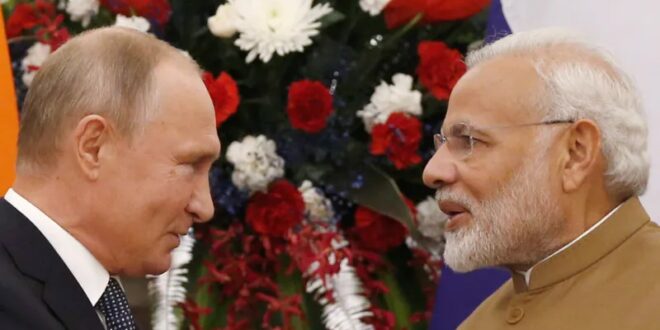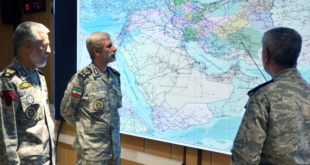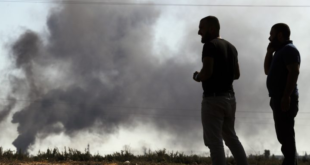The Ukraine Crisis Should Force New Delhi to Rethink Its Russia Policy
Ever since Russia began massing troops on the Ukrainian border, the government in Kyiv has been working frenetically to shore up international support. For the most part, it has focused on its partners in Europe and North America. Ukrainian President Volodymyr Zelensky has met with British Prime Minister Boris Johnson, French President Emmanuel Macron, and German Chancellor Olaf Scholz. He is regularly on the phone with U.S. President Joe Biden. Ukrainian Foreign Minister Dmytro Kuleba has conferenced with U.S. Secretary of State Antony Blinken, and he attended a December NATO ministerial meeting to discuss the Russian buildup. In a December article for Foreign Affairs, Kuleba called on the West to more actively and aggressively support Kyiv.
But on February 3, Kuleba made a blunt appeal to a country in a different part of the world: India. If India told the Kremlin in no uncertain terms that it found Russia’s actions “unacceptable,” this would be a “very strong message of support [for Ukraine] and make an impact,” Kuleba said. There is a reason for his plea. India is an important actor on the world stage, with strong ties to both Moscow and Washington. If it were to criticize Russia, New Delhi would at the very least demonstrate that the crisis worries countries beyond the West. It would signal that India strongly backs democracies and showcase that New Delhi is optimistic about the future of the Indian-U.S. partnership. And it would present a sharp contrast with China, which has been carefully silent about Ukraine.
Yet for India, the crisis is a highly fraught situation, and any action it takes vis-à-vis Ukraine carries significant risks. If it criticizes Moscow, India will alienate an important historical friend and, worse, drive Russia closer to China, which India considers its biggest foreign threat. If it backs Moscow, New Delhi will tank its relationship with the United States, a newer but highly valuable strategic partner. If it says nothing, India could antagonize both countries, which may then view it as a fickle and unreliable partner.
This underscores a mounting dilemma for New Delhi. India is a growing power in an increasingly multipolar world, and as disputes between countries grow more complex (and perhaps more common), they will want New Delhi’s support. India may not like this; the country has a long history of avoiding alliances, and it would rather focus on its own development while maintaining friendly ties with major international players. But international politics is not often kind to those who seek to remain on the sidelines without an ideological justification. During the Cold War, India was officially nonaligned, refusing to become enmeshed in superpower politics. This position sometimes made it unpopular (particularly with the United States), but it was widely accepted as its core moral ideology. India was a country newly independent from colonialism, and it refused to be a pawn of superpower imperialistic politics. In the post–Cold War world, India has talked about maintaining “strategic autonomy,” yet this repackaged version of nonalignment appears to be driven by economic and military self-interest rather than moral principles, and it has therefore not drawn the same degree of understanding. India does not need to involve itself in every conflict. But it and other emerging powers will need to recognize that as the world becomes more multipolar, tradeoffs will become more difficult to escape.
In the case of Ukraine, that means India should seize the initiative. New Delhi and Moscow have had friendly ties for decades, and the former can use the goodwill it has accumulated to quietly pressure Russian President Vladimir Putin into finding a diplomatic, face-saving solution. This may not come naturally to India, but stopping a full-scale war is critical to India’s global position. Russia has already moved military forces into two separatist regions of Ukraine for “peacekeeping purposes.” If the crisis escalates further into a Russian invasion, New Delhi has a lot to lose both economically—oil and gas markets will see unprecedented price surges—and politically. In India’s ideal world, the United States and Russia would both balance against China, and that will be impossible if they are in conflict.
INDEPENDENT AND DEPENDENT
India’s friendly relations with Russia predate the Cold War—and even its own independence in 1947. In the early twentieth century, India’s anticolonial nationalist leaders spoke favorably of the Soviet Union, which professed both socialist and anti-imperialist views that echoed their own opinions. From the perspective of India’s first prime minister, Jawaharlal Nehru, the Soviet Union was the unusual European country that rejected colonialism, publicly affirmed the principle of self-determination, and supported imperial subjects in their struggle for freedom.
The affection was not limitless. Joseph Stalin rejected India as insufficiently socialist and anticolonial (India joined the Commonwealth, much to his displeasure), and Nehru declined to draw India into a formal alliance with the Kremlin. But especially under Stalin’s successors, the Soviet Union offered New Delhi economic, technical, and military assistance that Indian policymakers were happy to accept. The Kremlin also gave India diplomatic support, including at the United Nations. During the 1950s, the Soviet Union backed New Delhi’s claims that the disputed territory of Kashmir was a purely bilateral issue. The Kremlin publicly supported India when it annexed the Portuguese colony of Goa in 1961, condemning Portugal’s colonialism as an affront to civilization. It supported New Delhi’s intervention in the Pakistani civil war on behalf of East Pakistan’s Bengali people in 1971. And in the years after the 1964 Sino-Soviet split, the Kremlin offered India security assistance—often without conditions and at substantial discounts—to protect itself against China, to which New Delhi lost a border war in 1962.
Nearly 70 percent of India’s military hardware is made in Russia.
For decades, this support helped India steady itself in a world where New Delhi faced constant threats from Pakistan, a serious menace from China, and indifference from the West. But it also meant that by 1991, India was utterly dependent on the Soviet Union for military equipment, including destroyers, tanks, submarines, field guns, and fighter jets—as well as for the spare parts and technology to maintain, repair, and upgrade them. Although New Delhi attempted to diversify its suppliers after the Soviet Union collapsed, it struggled to move off its existing systems and had to rely on Moscow for fixes and upgrades. Even today, nearly 70 percent of India’s military hardware is made in Russia.
New Delhi knows it needs to further diversify its procurement. It also knows that it needs new international partners. And over the last two decades, it has found one in Washington. In 2005, the United States and India signed a nuclear deal that lifted a moratorium on nuclear trade, provided aid to India’s civilian nuclear energy program, and expanded cooperation on satellite technology. In 2016, the United States declared that India was a “Major Defense Partner,” which gave India access to military and dual-use U.S. technologies. Over the next four years, the two countries signed three defense agreements. And along with Australia and Japan, India and the United States formed and began collaborating through the Quadrilateral Security Dialogue (Quad). Their partnership is driven by many factors, but one of the most important is India’s past and resurgent rival: China. The United States is locked in a contest with Beijing over global leadership and sees New Delhi as a powerful counterweight. India, for its part, is caught in border disputes with China and views working with the United States as necessary to check China’s growing encroachments in the region. By contrast, Russia has attempted to bury memories of the Sino-Soviet split, and it has drawn closer to China through initiatives such as the Shanghai Cooperation Organization.
New Delhi does not want to ruin its ties to Moscow, which is still a significant source of military equipment. (Last year, Russia delivered to India S-400 air defense systems.) India also wants to avoid a U.S.-Chinese cold war—despite their conflicts, the latter country is India’s second-largest trading partner—and it sees a strong Russia as a way to prevent a bipolar world. To a certain extent, New Delhi even understands why Russia does not want NATO in its backyard; India wants to maintain its own sphere of influence in parts of South Asia. And it certainly does not want to push Russia into a stronger alignment with China. India has therefore watched with concern as Moscow scales up its relationship with China and improves its ties with Pakistan, even as it has been heartened by Washington’s gestures of friendship. The world’s second-largest country is facing a predicament.
STUCK IN THE MIDDLE
During the last Ukrainian crisis, India implicitly sided with Russia. As much of the world condemned Moscow’s annexation of Crimea, it opposed Western sanctions against Russia. Shivshankar Menon, then national security adviser of India, stressed that Moscow had “legitimate interests” in Ukraine and that the annexation was “an internal issue.” The Indian Ministry of External Affairs said it would oppose “unilateral measures,” such as sanctions against the Russian government, in response to the Kremlin’s actions. Putin profusely thanked India for this strong support and later returned the favor. In 2020, India revoked Kashmir’s special autonomous status, provoking a broad, transnational backlash. But Moscow refused to condemn the act, using language that echoed Menon’s earlier description of Ukraine. “This is the sovereign decision of the Indian government,” said Nikolay Kudashev, the Russian ambassador to India. “It’s an internal matter.”
But this crisis looms larger than the last, and in the interim, India’s relationship with Washington has deepened. In 2020, the United States provided information and equipment to the Indian military in its border standoff with China. When New Delhi staged a diplomatic boycott of the 2022 Olympics, Washington offered public support. (Beijing made a soldier who had participated in attacks against the Indian military a torchbearer.) The two countries now regularly coordinate on regional security through the Quad, making it much more costly for New Delhi to openly support Moscow in the standoff over Ukraine.
India can help resolve the crisis by quietly pressuring the Kremlin.
In an attempt to stay out of the crisis, the Indian Ministry of External Affairs has called for a “peaceful resolution” and emphasized the need for “sustained diplomatic efforts” to resolve the situation. But this is a nonstatement that is unlikely to please either Russia or the United States. It will certainly not please Ukraine, which is home to roughly 20,000 Indian citizens. India’s efforts to stay silent could also lead Moscow to believe it has New Delhi’s support, something the government would like to prevent. When India abstained from a January 31 UN Security Council vote to discuss the crisis, the Russian permanent representative thanked India as well as China for its support.
Instead, India can help resolve the crisis by quietly pressuring the Kremlin to move toward a resolution. That means India should emphasize the long-term consequences of not reaching a diplomatic settlement. The Russian-Indian relationship is not one-sided—the former also benefits from the backing of the latter—and New Delhi should make it clear to Moscow that Russia cannot count on India’s support for an invasion of Ukraine. India should also remind Russia that it, too, has an interest in balancing against China, particularly in Central Asia, where both Moscow and Beijing have economic interests and want to establish a sphere of influence. A military confrontation, India could point out, would make it harder for Russia to compete against Beijing by isolating Moscow from other potential partners. The invasion could also possibly force Indian Prime Minister Narendra Modi’s government, which many international observers have repeatedly argued is autocratic, to move into an even closer partnership with the United States in order to defend its commitment to democracy and the Quad.
This will be an uncomfortable conversation for India to have. But it will be worth it, both for New Delhi and for the world. India is the only big power that can draw on decades of friendship to pressure Moscow and tell it hard truths. That means New Delhi is uniquely positioned not just to shore up its own geopolitical position but also to prevent a deeply destabilizing and extremely violent conflict. India’s alternative, trying to avoid the crisis in order to maintain “strategic autonomy,” won’t wash. Rather than advancing New Delhi’s interests or enhancing its global stature, staying silent will make India look like an opportunistic and self-interested partner, not worthy of greater cooperation or support.
 Eurasia Press & News
Eurasia Press & News




